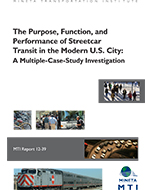- 408-924-7560
- mineta-institute@sjsu.edu
- Donate
The Purpose, Function, and Performance of Streetcar Transit in the Modern U.S. City: A Multiple-Case-Study Investigation
The streetcar has made a remarkable resurgence in the United States in recent years. However, despite the proliferation of streetcar projects, there is remarkably little work on the streetcar’s role as a transportation service. This study examines the experiences of the modern-era streetcars operated in Little Rock, Memphis, Portland, Seattle, and Tampa. The authors discovered that in these cities, the primary purpose of the streetcar was to serve as a development tool (all cities), a second objective was to serve as a tourism-promoting amenity (Little Rock, Tampa), and transportation objectives were largely afterthoughts with the notable exception of Portland, and to a lesser degree, Seattle.
Key informant interviews revealed that in most cities, private sector actors from the local development and downtown business communities as well as streetcar advocacy groups were the key forces behind streetcar implementation and that these actors did so in order to use the streetcar primarily to achieve development goals. These informants viewed the streetcar as a catalyst for development that stood as a symbol of a permanent public commitment to an area. Despite the lack of serious assessments of the streetcar’s development effects, most informants believed the streetcar to be an important contributor to any development effects that had occurred. Many informants also regarded the streetcar as an icon or symbol of the community and an important way of denoting the city’s identity in efforts to attract visitors to the community.
When assessed as transportation, Portland’s streetcar emerged as the clear standout performer with the highest ridership and service productivity and the second-most cost effective service. Portland was also the only city in which streetcar performance (service productivity and cost effectiveness) measures surpass that of the average local bus. Planners’ decisions to locate the streetcar lines in an area with strong ridership potential combined with decisions to provide frequent service that is well integrated with other transit services help to explain Portland’s strong performance. These decisions reflected a view that the streetcar was not just a development tool, but that it also needed to function effectively as a transit service that catered to a broader ridership.
Based on this study, the authors suggest that planners and policymakers in other cities think carefully about the fundamental purpose of any proposed streetcar in their communities and to proceed in all their decision making with that fundamental purpose clearly in mind. The authors also urge planners and policymakers in other cities to regard the example of Portland with much more caution. Many streetcar advocates point to Portland’s experience and proceed as if it could be easily replicated elsewhere. But the authors suggest that Portland’s experience is the result of a unique combination of external factors (local population and employment patterns, the health of the real estate market) and local decisions (land development policy decisions, financial decisions, other public investments, streetcar alignment location and length, streetcar operations decisions, streetcar fare policy decisions) that may or may not be applicable elsewhere.
JEFFREY BROWN, PhD
Dr. Jeffrey Brown is Associate Professor, Department Chair, and Master’s Program Director in the Department of Urban and Regional Planning at Florida State University. His research interests include transportation finance, transportation history, and public transportation policy and planning. He holds a B.A. in Geography, an M.A. in Urban Planning, and a PhD in Urban Planning from the University of California, Los Angeles.
HILARY NIXON, PhD
Dr. Hilary Nixon is an Associate Professor of Urban and Regional Planning at San José State University. Her research and teaching interests in environmental planning and policy focus on the relationship between environmental attitudes and behavior, particularly with respect to waste management and linkages between transportation and the environment. She holds a BA in Environmental Management from the University of Rochester and a PhD in Planning, Policy, and Design from the University of California, Irvine.
LUIS ENRIQUE RAMOS, M ARCH, MP
Luis Enrique Ramos is a doctoral student in the Department of Urban and Regional Planning at Florida State University. His research interests include the evolution of inner-ring suburbs, multidisciplinary social-ecological urban research, sustainable transportation, determinants of transit ridership, and transportation/ land-use interactions. He holds a Bachelors and a Masters in Architecture from Tulane University, New Orleans and a Masters in Urban and Regional Planning from the University of Puerto Rico – Graduate School of Planning.
-
Contact Us
San José State University One Washington Square, San Jose, CA 95192 Phone: 408-924-7560 Email: mineta-institute@sjsu.edu






